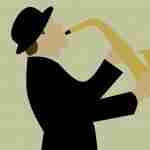You walk into your practice room. You sit back in your favorite chair and mentally prepare to play your first note of the day. You glance at your stack of etude books, the half transcribed solo sitting on your music stand, and your growing list of tunes to learn and you let out a heavy sigh.
What are you going to practice today?
Sound familiar? Thought so.
Every musician knows this feeling well. Each time you pick up your instrument you’ve got to make a decision: Which type of practice is actually going to make you a better improviser?
Sure, we’ve all heard about the basic stuff, but in the back of our minds we’re secretly hoping to find that one perfect exercise or method that’s going to solve all of our improvisational woes.
However, it’s not that simple. The more you study and perform this music, the more you’ll realize that there isn’t a magic method for learning improvisation. The truth is each player has a personal way of approaching their time in the practice room that allows them to reach their goals.
So how do you sort through all of these methods to find the one that works for you?
Well the good news is that you don’t have to! You see, it isn’t one single method or practice plan that makes a player succeed, it’s the actual content of what’s happening in the practice room.
Take a closer look and you’ll see that every great practice routine for jazz improvisation consists of 6 essential parts:
1) Hey listen!
The one simple thing that you can do each day to improve every aspect of your musicianship is listening.
It’s as simple as that.
Just press play and open your ears.
Each day you need to listen to the music or musicians that inspire you. Take in the musical styles that you’re trying to learn and absorb the techniques you’re striving to acquire.
Whichever instrument you play and whichever style of music you gravitate toward get “that sound” in your ear. Visualize it in your mind and remember it when you go to play your own instrument.
You can’t become a great musician without a goal – you need to start with a target in your mind and a sound in your ear.
Want to sound like John Coltrane? Listen to John Coltrane.
Want to improve your playing over odd meters? Listen to tunes in 3, 5, and 7.
Out of ideas over Rhythm Changes? Listen to it first!
Listening ingrains the sound of music in your ear. It inspires you and gives you ideas. Listening defines the fundamentals and stylistic foundation of any music in your mind.
If there’s one easy thing that you can do everyday to make yourself a better improviser, it’s listening. Make sure you do it everyday.
2) Get technical
No matter which type of music you play, you need to be able to produce sound on your instrument.
You need to be able to play in every key, you need to be able to play in time, and you need to have access to the entire range of your instrument.
This requires technique.
While your instrument is not the primary source of your musicality, it is an essential piece in getting your musical message across to an audience. You can have amazing musical ideas hiding in your mind, but if you can’t physically produce these sounds on your instrument it’s useless.
Think about it.
Picasso needed to learn how to hold a paint brush, Louis Armstrong had to learn the basic trumpet fingerings, and Beethoven had to study counterpoint. Even the most gifted artists had to start with the fundamentals of their craft.
“The more technique you have, the less you have to worry about it. The more technique there is, the less there is.”~Pablo Picasso
This technique wasn’t the central focus of the their mastery, rather an important piece that allowed it to happen. Without a solid foundation of basic technique none of those masterpieces would have been created. It’s the same for you.
You need to develop effortless technique on your instrument so that you can produce the music that’s happening inside your mind. This means spending focused time on your sound, time, fingers, range, and articulation. And it means overcoming your technical limitations.
There are a number of ways to maintain and improve your instrumental technique and the best part is, the way you gain this technique is completely up to you.
Try to combine one or more of these practice areas into a single exercise. For example something as simple as the practice of a major scale can include finger technique, facility in every key, articulation, range, and time & rhythm. With attention and intent, even the most basic musical exercise can encompass every aspect of your musicianship.
3) Train those ears
If you want to be a successful improviser you need good ears.
In fact, you need great ears.
Not only do you need to know the essential elements of melody and harmony, you must immediately recognize these details in real time.
What does the Major 7th sound like?
What does a minor 9 chord sound like?
What does a ii-V-I sound like?
What does a Blues progression sound like?
The only way to get this information in your ears is with some ear training practice. Your ears aren’t going to get better by themselves – you have to work on them in the practice room and put them to the test on stage.
Your ability to learn tunes by ear, to hear the movement of chord progressions, and to transcribe solos goes directly back to your ability to hear the fundamental elements of music. Start by incorporating some ear training exercises into your daily routine:
You can even use pop tunes to improve your ear. Remember, ear training can happen anywhere.
4) Develop some piano skills
Every musician should have a working knowledge of music theory.
More specifically, a familiarity with the construction of scales, intervals, and chords and the relationships between these chords.
But what’s the best way to absorb all of this information?
You can memorize these concepts out of a book, you can look at pages of written scales, and you can even recite the rules of harmony in your mind…or you can just go to the piano.
When it comes to understanding music theory, there is no better tool than the piano. Not only can you hear each interval, chord, and progression, on the keyboard you can see it!
Nearly every great player that you love to listen to is also proficient on the piano – and you should be too! Here are two articles to get you started:
Whether you’re a complete piano novice or an experienced player, get some time in each day at the keyboard. Work out the chord progressions to the tunes you’re learning, analyze the lines that you’ve transcribed, and work on composing your next tune.
5) Start Transcribing
The first step to transcribing is understanding what it is and what it isn’t.
At it’s core, transcribing is the process of learning something by ear from a recording. That “something” could be a melody, a bass line, a chord progression, or a phrase from your favorite solo.
This process is essential to your development as an improviser. When you transcribe you’ll gain musical benefits like:
- Focused Ear training practice
- Strengthening the connection between your ears and your instrument
- Understanding and hearing chord progressions
- Acquiring musical vocabulary and language
- Learning the stylistic elements of improvising (articulation, time, swinging, and phrasing)
You can’t get these skills from a book, you have to deal with the music directly and seek out the answers yourself. If you truly want to improve as an improviser you should be learning something new by ear each time you practice your instrument.
6) Tunes, tunes, tunes
As you evolve as a musician you’ll hear a lot of players talking about not knowing enough tunes, but not many talking about practicing tunes.
The problem is that we forget about the importance of learning tunes until it’s too late.
We forget until that moment that we’re on the stage and someone asks “Hey do you know this tune?…” or that moment when we’re playing with some friends and they ask you “So what do you want to play next?”
Then we remember.
Don’t wait until you are put on the spot, start focusing on tunes in your daily practice. To get started, check out the following articles:
Creating Your Next Practice Session
You’re a serious musician and you practice all the time.
Of all the possible ways that you can use this time with your instrument, you have to find the exercises that will actually make you a better player.
There are hundreds of resources out there: Books, DVDs, YouTube videos, online lessons, music apps… It seems like everyone and their brother has a method for improvising! But how do you sort through all of this noise to find the stuff that works you.
Well, stop for a second and take a look at the bigger picture. The great Mulgrew Miller once said he didn’t believe in one method, system, or school of thought for learning this music and this advice couldn’t be more true.
Think about all of the great players throughout the history of this music. These players came from different backgrounds, different walks of life, and learned the music in different ways. Despite their wide ranging beginnings and unique paths to this music, they all found a way to sound great with their own musical voice.
You don’t have to practice out of a certain book, you don’t have to learn a certain set of scale patterns, and there isn’t one set way or system that you must use to learn this music.
However, there is a clearly defined set of skills that you need to become a successful improviser. You need to:
- Listen to the music that you’re trying to learn
- Develop your instrumental technique
- Improve your ear
- Spend time at the piano understanding the construction of melody and harmony
- Transcribe and learn the music by ear
- Build a repertoire of tunes
The skills that you need are defined, but the way that you acquire these skills is up to you.
So here’s where you come in. Each day you need to create a practice plan in which you utilize each of these 6 areas. Chances are you’re already covering some of these in the practice room, now the challenge is to cover all of them – good luck!














